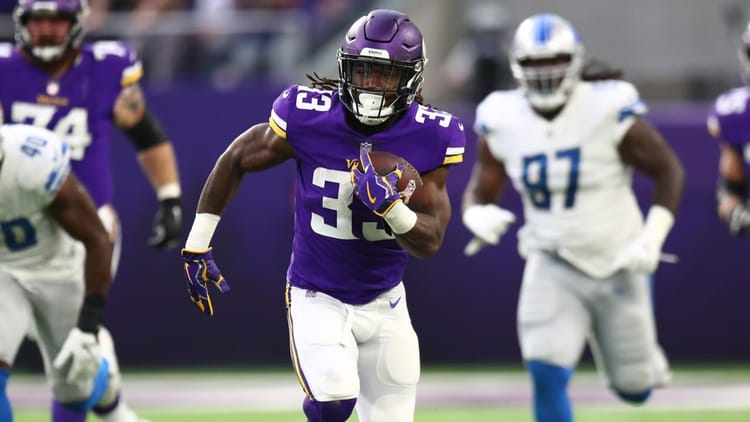Why 2020 is Important for NFC North Running Backs

It’s safe to say three years later that the 2017 NFL Draft was a strong class for running backs. It’s also a class that the majority of the NFC North took advantage of (sorry Detroit, if only you picked Marlon Mack in the fourth round instead of Michael Roberts). Minnesota drafted Dalvin Cook in the second round, Chicago selected Tarik Cohen in the fourth round, and Green Bay selected Aaron Jones in the fourth round. With all these backs in the same division, 2020 is a big year for the NFC North for a number of reasons. Let’s dive into why.
Secure the Bag
All three of Cohen, Cook, and Jones have yet to agree to a contract extension and are set to enter unrestricted free agency at the end of the 2020 season. That is, if a deal is not reached during the season. With the recent extension given to Joe Mixon, and expected extension for Alvin Kamara after a few days of turmoil, these backs will probably be hoping to get a pretty penny. However, that will require a season of play that backs these expectations. If they do not let their play do the talking, one of these teams may choose to move on with backs like Travis Etienne and Najee Harris set to be draft eligible in 2021.
Jones probably has the best case for his extension after coming off a career season in 2019. He scored 19 touchdowns and gained over 1500 yards from scrimmage, securing himself as a top threat at the position. He is also set to carry the Green Bay backfield again as their top rushing and receiving player out of a backfield that includes Jamaal Williams and 2020 second round pick, A.J Dillon. The one thing that could derail Jones’ 2020 campaign is if his injury history rears its ugly head again. Jones suffered three right MCL sprains in 2017 and 2018.
Cohen on the other hand, may be coming off the most disappointing season of his career. Cohen was the one bright spot on Chicago’s offense in 2018, but he was not able to follow up in 2019. Sharing time with David Montgomery certainly had to do with part of that, but as a second year player, Montgomery will be in Chicago for the foreseeable future. In order to get his deal, Cohen will have to show that he is still a threat in the passing game. In 2018, Cohen tallied 725 receiving yards, but this production dropped to 456 yards in 2019, despite garnering more targets with 104 compared to 91 in 2018.
Cook may be under the most pressure of the three to perform. He enters 2020 after his best season, but he still has many questions to answer. In 2019, Cook rushed for over 1000 yards for the first time, and he scored 13 touchdowns. However, Vikings fans are far too familiar with his injury history. He only played four games his rookie year because of a right ACL tear. Then in his sophomore season he missed five games due to a hamstring sprain. Cook also has a scary history with shoulder injuries, suffering torn labrums in 2014 and 2016. Even last year, he missed two games with an A/C joint sprain in the same shoulder. With this extensive history, Cook needs to be healthy in 2020 and may be one more injury away from missing out on a big contract no matter how much talent he has.
The Peak is Coming…Or Could it Have Already Passed?
Predicting the timeline of an NFL running backs peak has always been nearly impossible. Some backs, like Alfred Morris and Demarco Murray, have broken into the league very young just to not quite reach their peaks again. On the other hand, with today’s advanced science and nutrition, Adrian Peterson and Frank Gore have found ways to remain productive into their mid 30s.
While it is certainly possible that these backs remain relevant for years to come, the end of Aaron Jones being able to run over defenses is almost certainly approaching more quickly than we think. Looking at pro-football-reference.com, of the top 100 rushing seasons all time, 67 of them have come before at age 26 or earlier.
Now granted, that may have something to do with rushing being a larger part of past NFL where injuries were more likely to derail a career. So, I decided to look at total yards from scrimmage as well to take into account a backs receiving yards. The results show even more youth. Of the top 100 season totals, 70 came at age 26 or earlier.
If you want to completely discount historic numbers and only look at modern day, the trend is even worse. Nine of the top ten yards from scrimmage totals during the 2010s came at age 26 or earlier, and the lone outlier was Peterson’s historic 2012 season.
To summarize, Cohen, Cook, and Jones have the potential to remain relevant, but I don’t think we can assume that the level of production we saw in 2018 from Cohen or in 2019 from Cook and Jones is a lock for the next few years. They will need to prove in 2020 that they can continue to produce, or they risk losing an opportunity for an extension or a big contract in free agency.
